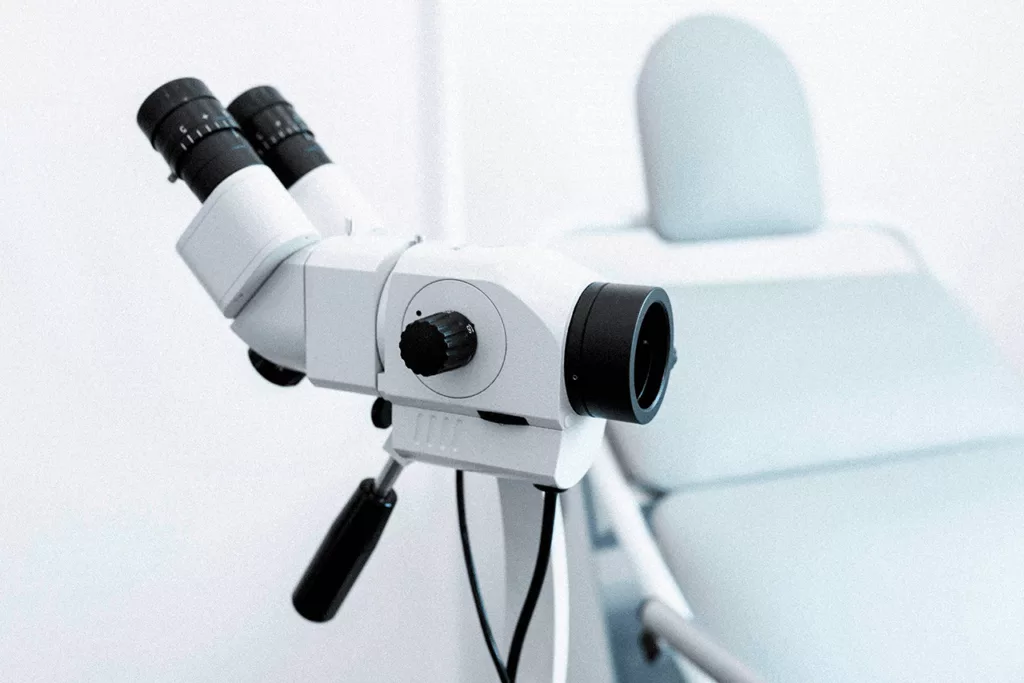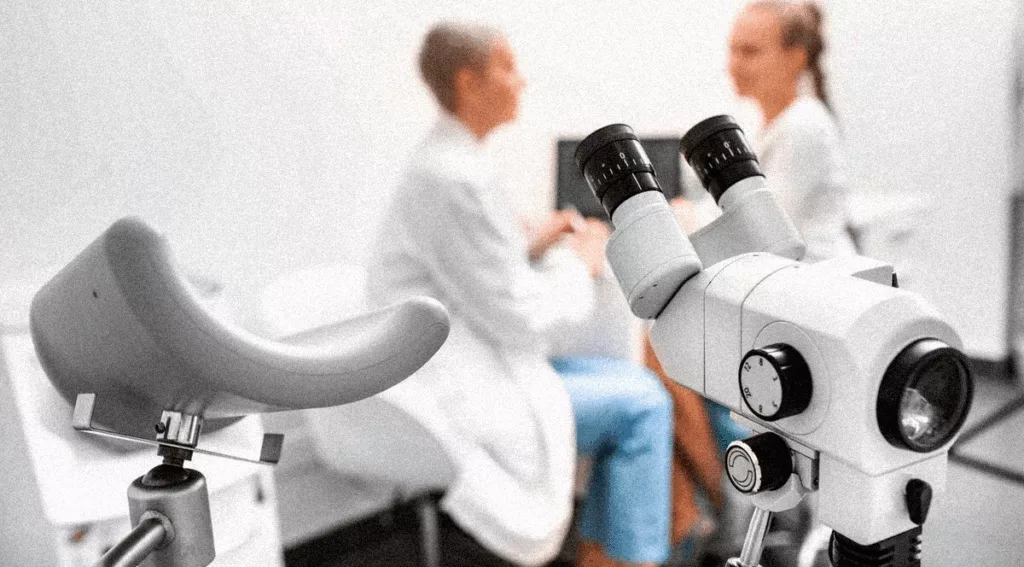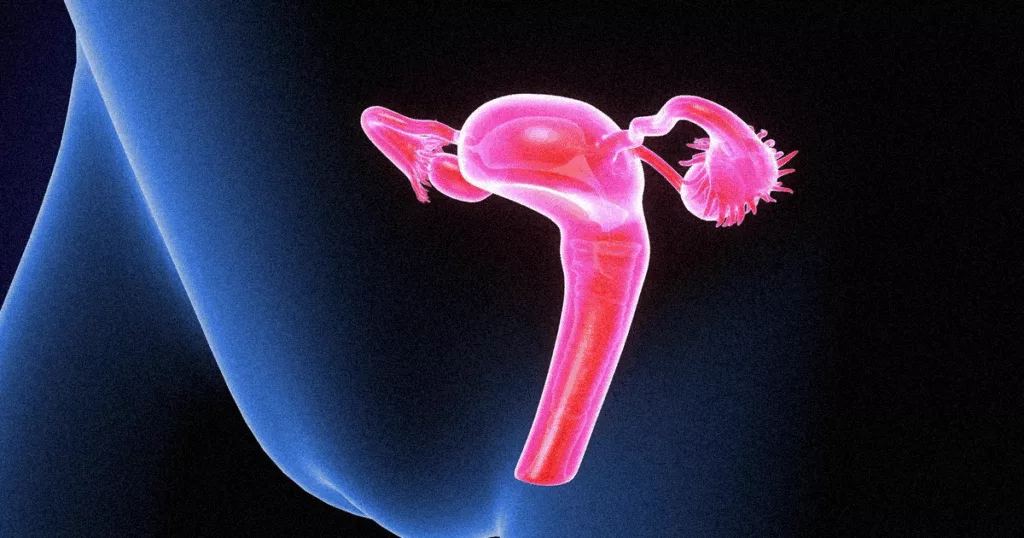Colposcopy in Warsaw
COLPOSCOPY
OF THE CERVIX
Colposcopy is an examination that assesses the condition of the cervix, vagina, and vulva. It is performed to diagnose precancerous conditions and lesions. The procedure allows detection of even the smallest tissue changes that may not be visible during a regular examination. If you have abnormal cytology results or recurrent infections, colposcopy can help identify the problem and ensure timely treatment. The examination is conducted by an experienced doctor and is a safe, quick, and highly informative method for evaluating women’s health.
Make an appointment for colposcopy in Warsaw
⬇️
Highlights
- Colposcopy is a non-invasive gynecologic examination that helps diagnose precancerous conditions of the cervix and detect HPV-related lesions.
- Colposcopic examination is recommended for abnormal cytologic findings, suspected precancerous lesions, and recurrent infections.
- Preparation for colposcopy includes abstaining from sexual intercourse and using vaginal preparations 24-48 hours before the examination, which affects the accuracy of the results.
Colposcopy - what is this examination?
Colposcopy is a non-invasive gynecologic examination that evaluates the lower genital tract, including the cervix, vagina, and vulva, within the lower genital tract, and evaluates cervical ectopia.
The main purpose of this examination is to diagnose precancerous conditions.
During a colposcopy, the doctor performs an evaluation:
- cervix
- lower cervical
- vagina
- inside the cervix
- vaginal cervix
- vulva
- cervix
- vaginal cervix

This allows for the detection of erosions, infections, precancerous conditions and cancerous lesions.
Colposcopy is particularly important for the prevention of cervical cancer because it allows the detection of lesions associated with HPV infection, which is a major risk factor for this type of cancer. Indications for colposcopy may include abnormal cytologic findings, suspicion of precancerous conditions and recurrent infections. Cervical cancer is one of the most important topics in this field.
With colposcopy, a diagnosis can be made quickly and appropriate treatment administered, greatly increasing the chances of recovery.
Indications for colposcopy

Colposcopy is recommended in several key situations. These include:
- If the cytology results are abnormal.
- If your doctor notices changes during a gynecologic exam.
- Suspicion of anterior neoplastic lesions.
- Recurrent vaginal infections.
- Diagnosis of cervical cancer.
Therefore, colposcopy is the next diagnostic step in such cases.
Other indications for colposcopy include diagnosis of papillomas, temporal lesions and evaluation of cervical ectopia. Colposcopy plays a key role in the prevention of cervical cancer by allowing early detection and removal of precancerous growths, which can save a patient’s life.
Preparation for colposcopy
Preparation for colposcopy is crucial for accurate results. Here are some recommendations to pay attention to:
- Avoid sexual intercourse 24-48 hours before the test.
- Do not use vaginal preparations during the same period.
- Do not undergo other gynecologic examinations on the day of your routine colposcopy to avoid possible influence on the results.
By following these steps, you will increase your chances of getting valid survey results.
Colposcopy is best performed in the first half of the menstrual cycle, after bleeding has stopped, as colposcopy should not be performed during menstruation or other genital bleeding. It is also important to avoid anti-inflammatory treatment before the examination, as this can affect the results of the test.
How does colposcopy work?

Colposcopy is a non-invasive procedure that allows you to accurately examine your cervix using a colposcope. A colposcope is a specialized optical instrument that allows you to magnify the image up to 50 times, allowing you to accurately assess the damage. During the examination, the doctor uses various filters and solutions, such as acetic acid and Lugol’s liquid, to better see potential lesions.
The examination usually lasts from a few to several minutes, after which the patient can leave the office on her own. During colposcopy, the doctor may decide to immediately take slices for histopathologic examination if he or she notices any alarming changes. This makes it possible to quickly diagnose precancerous conditions, which increases the chances of a cure.
Cervical colposcopy is performed while lying on your back in a gynecologic chair. The doctor inserts a mirror into the vagina to get better access to the cervix. Then, with the help of a colposcope, he carefully examines the surface of the cervix, using appropriate solutions to contrast the affected areas. The entire process is painless and non-invasive, making it a standard gynecologic examination.
Does it hurt to have a colposcopy?
Colposcopy is usually painless, and patients may experience only minor discomfort. The procedure is non-invasive, and specialists use lubrication to minimize discomfort during the exam. During colposcopy, you may feel a slight burning sensation when the sample is taken, but it is not severe pain.
Mild burning and discomfort may occur during tissue sectioning. However, most patients describe these sensations as minimal and short-lived. Colposcopy is an important examination to help diagnose and prevent cervical cancer, and any discomfort is a small price to pay for the possibility of early detection of precancerous lesions.
Colposcopy results
The results of colposcopy are available almost immediately after the examination, allowing a quick assessment of the cervix. If a biopsy is performed during colposcopy, the waiting time for histopathologic results is approximately 1-2 weeks. These results are crucial for therapeutic decisions regarding cervical disease because they accurately determine the nature of the lesion.
Colposcopy can quickly and effectively detect precancerous lesions, which is extremely important for the prevention of cervical cancer. With the immediate results of colposcopy, patients can quickly take further diagnostic or therapeutic measures, which increases their chances of recovery.

Colposcopy with biopsy
Vaginal colposcopy with biopsy is an examination during which tissue slices are taken for further histopathologic analysis. This procedure allows you to scrutinize whether there are lesions in the cervix that may require further treatment. Taking a biopsy can be painful, so local anesthesia is often used to minimize patient discomfort.
Biopsy is crucial in the diagnosis of precancerous lesions and cervical cancer.The biopsy material is sent to the laboratory, where a histopathological examination is performed, which shows the presence and nature of the lesion.The results of the biopsy are necessary to decide on further treatment and to monitor the patient’s condition.
Potential risks and side effects of colposcopy

Colposcopy is generally a safe examination, but like any medical procedure, it can have certain risks. Rare complications include heavy bleeding and genital tract infections. After a colposcopy, you may experience minor temporary discomfort as well as light bleeding, which is usually normal.
After colposcopy, it is recommended to avoid sexual intercourse and the use of tampons for a few days to reduce the risk of infection. If you feel chills, fever or severe pain in the lower abdomen, contact your doctor immediately, as these may be signs of complications that require medical attention.
Colposcopy in pregnancy
Colposcopy is completely safe for pregnant women and carries no risk to the fetus. Colposcopy screening can be performed during pregnancy to detect precancerous lesions, which is crucial for early diagnosis.
Colposcopy with biopsy can also be performed during pregnancy, but no cervical puncture should be performed to avoid disturbing the structure of the cervix and inducing premature labor. Colposcopy during pregnancy allows you to monitor the health of the woman and provide appropriate medical care.
Cost of colposcopy
The cost of colposcopy at private clinics can vary considerably. Prices start from £150 and can go up to £600, and in some prestigious establishments the cost can exceed £1,000. For many patients this can be a significant expense, so it is worth being aware of alternative options.
Women between the ages of 25 and 59 are eligible for reimbursement of colposcopies by the National Health Service, which can significantly reduce the costs associated with the examination. It is worth speaking to your gynecologist to find out more about reimbursement and the funding options available.
What should I do after a colposcopy?
After the colposcopy, you can quickly return to your daily routine. You can return to your daily activities almost immediately. You can begin to resume your activities immediately after the examination, which is one of the advantages of this procedure. Minor irritation or burning may occur, but these are temporary symptoms that should not significantly affect your daily life.
However, it is recommended that you avoid sexual intercourse and the use of tampons for a few days after the biopsy to reduce the risk of infection and to ensure adequate healing of the excision sites. It is important to monitor your body and contact your doctor if you experience any alarming symptoms.
Bottom line
Colposcopy is a non-invasive examination that plays a key role in the diagnosis and prevention of cervical cancer. It allows the detection of pre-neoplastic lesions, which is crucial for early diagnosis and effective treatment. Preparation for colposcopy, its course and interpretation of the results are important elements that every woman should know in order to consciously take care of her health.
Regular checkups and consultations with a gynecologist are encouraged. Early detection of lesions can save lives, and colposcopy is one of the tools that makes this possible. Let’s take care of our health and not be afraid to ask specialists about anything that bothers us.
Common questions
Colposcopy is usually not painful, although patients may experience slight discomfort or a slight burning sensation while the sample is being taken. It is important to report any symptoms to your doctor.
Colposcopy results are usually available immediately, but if a biopsy is performed, histopathological results must wait about 1-2 weeks.
Colposcopy is safe for pregnant women and carries no risk to the fetus. It can be performed in appropriate clinical situations.
Colposcopy is generally safe, but there is a risk of rare complications such as heavy bleeding and reproductive tract infections. It is important to be aware of these risks before proceeding with the examination.
The cost of colposcopy in private clinics ranges from 200 to 600 PLN, and in some cases may exceed 1000 PLN. For women between the ages of 25 and 59, the cost of colposcopy can be reimbursed by the National Health Fund.